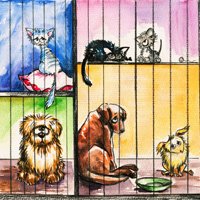Your kids have been begging you for a puppy for months. You finally relent. You pile everyone in the car, head to the local animal shelter, and get ready to choose the furry face who is going to turn your world upside down.
But when you arrive to a chorus of barking dogs in chain-link kennels at the city shelter, the door is locked and the sign out front says, “No public adoptions.” But isn’t that what animal shelters are for?
Not in Vermilion, La., Smith County, Texas, or Liberty County, Ga. Citing a combination of cost and liability, these taxpayer-funded facilities are merely holding stray and surrendered animals until a licensed rescue tries to pull the pets to safety, or the animals are simply killed.
Granted, staffing an animal shelter or impound facility is not a cheap endeavor, costing an average of anywhere from $10 to $40 per animal per day, depending on the amount of medical care, kennel staff, and outreach a facility does, but is that any excuse to deny the public a chance to help save lives?
Increasingly, adoption is becoming a popular way to acquire a family pet. The idea of saving a life appeals to more and more Americans these days, who recognize supporting a backyard breeder or puppy mill is a less compassionate choice than letting an equally lovable pet languish, and possibly die, in a shelter. However, when animal control facilities opt to leave the “happy ending” out of their day-to-day routines, it is a tragic and completely unethical model to follow.
In 2012, Smith County alone euthanized more than 10,000 dogs. Without a staff to do temperament testing to clear pets for adoption, handle the adoption process, and work to proactively network these pets, it is likely many of these dogs died because they were in the wrong place at the wrong time.
Many of these facilities partner with local rescues to try and get some of animals out of the pounds, but their kennels are constantly full, so euthanasia is scheduled for the same day every week to “make room.” The situation is not limited to these three facilities either. This process happens at dozens of pounds throughout the country, most of which are in the southern states, where pet overpopulation runs rampant. Dogs and cats, no matter how friendly, are held for the state mandated 72 hours for strays, (or even less for owner-surrendered pets), and then they become at-risk for euthanasia.
To change this process, many underfunded public shelters have begun contracting out their shelter operations to non-profit entities, but that is not without struggle. Costs and liability still exist, but are absorbed by another entity and facilities are often so out-of-date, that the conditions border on inhumane and need significant improvement just to house the pets safely, not to mention attract adopters.
Thousands of open-admission shelters work hard, day and night, to find homes for their pets and reduce euthanasia against challenging odds, but how can Americans spend over $53 billion a year on our pets, while thousands of animals at these impound facilities are dying because the funding isn’t there to let anyone know that they ever existed?









